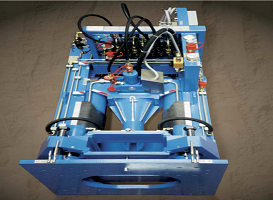Live Mains Insertion is a technique that falls between Pipe Replacement and Lining Techniques.
It is considered by some operators as a renovation system that is a companion method to dead mains insertion or Sliplining. To others it is a technique that falls into the Pipe Replacement sector as it replaces an old pipe with a new pipe that has no structural reliance on the old pipe once the insertion is completed.
Live mains Insertion is primarily used in the gas industry to replace old metal low pressure gas pipelines with new plastic (PE) pipes within the diameter range 3 in (75 mm) and 18 in (450 mm), without the need to take customers off supply during the operation to provide the new pipe. The installation operation is achieved by using a specially developed pipeline access system known as a Glandbox™.
The old main is kept live throughout the insertion process and the new PE pipe is gassed up (pressurised) to maintain gas supplies to customers. When inserting PE up to 180 mm diameter it is usual to ‘gas up’ the PE replacement pipe prior to insertion and use a live head to allow gas to pass between the PE pipe and the annulus.
The replacement PE pipe for diameters up to 180 mm is normally supplied in a coil. Above this diameter, where straight sticks of PE pipe are used instead of a coil, it is possible to carry out the procedure without first gassing up the replacement PE pipe.
The installation process uses either a pipe pushing machine that is set in the launch excavation or a pipe handler that is attached to an excavator to insert the PE replacement pipe into the old main. A ‘live’ head, designed with holes to allow for the flow of gas, is fitted to the end of the replacement PE pipe.
This pipe is then pushed into the gland box until the plastic membrane within is pierced. Gas is then allowed to flow into the replacement PE pipe and the PE pipe is pushed to the end of the replacement section. During this operation the gas supply to customers is maintained. The PE replacement pipe is then connected to the gas network pipe and the existing main is kept live to supply customers via the annular space until it is operationally convenient to transfer the services to the new PE main. The use of pipe pushing machines and/or pipe handlers and pipe coil trailers is necessary for the safe, efficient implementation of live mains insertion.
Customer services are transferred to the new PE pipe sequentially using polyurethane foam flowstop technology to block the annular space. This is the only time customers will not have a gas supply and this is only for the time it takes to transfer the service pipeline to the new PE pipe. However, there is a need to utilise traditional excavation techniques to remake the service connections. But the use of the flowstop technology does allow the contractor to plan and minimise these excavations to meet the needs of customers and the local area infrastructure.
Some contractors have utilised keyhole vacuum excavation techniques to make the service connections, over the past few years this option has become more widely adopted by clients and their contractors but has not yet found it mark as an industry wide standard practice.







